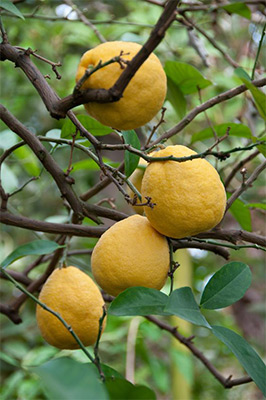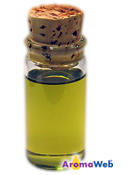Bergamot Essential Oil
Citrus bergamia

Description
Bergamot Essential Oil is one of my favorite citrus oils to enjoy in the diffuser and to mindfully use in topical applications.
The aroma of Bergamot Essential Oil is reminiscent to that of Orange Oil, but it is wonderfully more complex. It almost seems to possess an underlying floral characteristic to it, most likely due to its composition of the ester Linalyl Acetate.
Drinkers of Early Gray tea are especially familiar with the flavor and aroma of bergamot as the rind is used to flavor the tea.

Bergamot Essential Oil may be helpful when used mindfully during periods of depression, sadness or grief. Unlike other citrus rhind essential oils that are commercially available, Bergamot Oil contains approximately 30% Linalyl Acetate, and ester that can have a calming or soothing effect. Linalyl Acetate is also present in Lavender Essential Oil and Clary Sage Essential Oil and is the component that significantly contributes to the relaxing properties of these oils.
Bergamot Oil is also known for its ability to help combat oily skin and acne. However, it must be used very careful on the skin. Cold pressed Bergamot Essential Oil is highly phototoxic, and it must be avoided when exposed to the sun or UV rays. Bergaptene is the naturally occurring constituent found in cold pressed Bergamot Essential Oil that makes the cold pressed oil phototoxic. Varieties of furocoumarin-free (FCF) cold pressed Bergamot Essential Oil are available that have the bergaptene removed. Bergamot Oil is also sometimes available as a steam distilled oil.

Bergamot Essential Oil Benefits and Uses
- Acne
- Abscesses
- Anxiety
- Boils
- Cold Sores
- Cystitis
- Depression
- Halitosis
- Itching
- Loss of Appetite
- Oily Skin
- Psoriasis
- Stress
Source: Julia Lawless, The Encyclopedia of Essential Oils (Updated Edition) (London: Harper Thorsons, 2014), 48-49.
Botanical Name
Plant Family
Common Method of Extraction
Cold Pressed or Steam Distilled (less frequently)
Plant Part Typically Used
Color of Bergamot Essential Oil
Green/Golden
Consistency
Thin
Perfumery Note
Top
Strength of Initial Aroma
Medium
Aromatic Description
Bergamot Essential Oil smells citrusy and possesses a beautifully complex aroma with underlying floral and bitter characteristics.
Major Constituents of Bergamot Essential Oil
- (+)-Limonene
- Linalyl Acetate
- Linalool
- Sabinene
- Gamma-Terpinene
- Bergapten
See Essential Oil Safety for a more complete list of typical constituents.

Source: B.M. Lawrence, Essential Oils 1981-1987 (Wheaton: Allured Publishing, 1989), 39-40. B.M. Lawrence, Essential Oils 1988-1991 (Wheaton: Allured Publishing, 1993), 7, 175.A. Verzera, A. Trozzi, I. Stagno D'Alcontres, et al., The Composition of the Volatile Fraction of Calabrian Bergamot Essential Oil. (Riv. Ital. EEPOS 25, 1998), 17-38. P. Dugo, L. Mondello, A.R. Proteggente, et al., Oxygen Heterocyclic Compounds of Bergamot Essential Oils. (Rivista Italiana EPPOS 27, 1999), 31-41. SCCP, Opinion on Furocoumarins in Cosmetic Products. (Scientific Committee on Consumer Products, 13-Dec.-2005), SCCP/0942/05. Sources cited in Robert Tisserand and Rodney Young, Essential Oil Safety (Second Edition. United Kingdom: Churchill Livingstone Elsevier, 2014), 211.
Bergamot Essential Oil Safety Information
Cold pressed Bergamot Oil is phototoxic. Tisserand and Young recommend a dermal maximum use of 0.4% to avoid phototoxicity. Reading Tisserand and Young's full profile on this oil is recommended. [Robert Tisserand and Rodney Young, Essential Oil Safety (Second Edition. United Kingdom: Churchill Livingstone Elsevier, 2014), 87, 211.] Rectified FCF/Bergaptine-Free versions of cold pressed Bergamot Oil are available that dramatically reduce the phototoxicity of the oil.
General Safety Information
Do not take any oils internally and do not apply undiluted essential oils, absolutes, CO2s or other concentrated essences onto the skin without advanced essential oil knowledge or consultation from a qualified aromatherapy practitioner. For general dilution information, read AromaWeb's Guide to Diluting Essential Oils. If you are pregnant, epileptic, have liver damage, have cancer, or have any other medical problem, use oils only under the proper guidance of a qualified aromatherapy practitioner. Use extreme caution when using oils with children and be sure to first read the recommended dilution ratios for children. Consult a qualified aromatherapy practitioner before using oils with children, the elderly, if you have medical issues or are taking medications. Before using this or any essential oil, carefully read AromaWeb's Essential Oil Safety Information page. For in-depth information on oil safety issues, read Essential Oil Safety by Robert Tisserand and Rodney Young.
Shelf Life
Important Information About the Profiles
The essential oil information provided on AromaWeb is intended for basic educational purposes only. The references to safety information, test results, constituents and percentages is generalized information. Essential oils can vary greatly in composition. The data is not necessary complete and is not guaranteed to be accurate. The essential oil photos are intended to represent the typical and approximate color of each essential oil. However, essential oil composition and color can vary based on harvesting, distillation, age of the essential oil and other factors. Profiles for several CO2 Extracts and absolutes are included within the directory, and are denoted as such.
